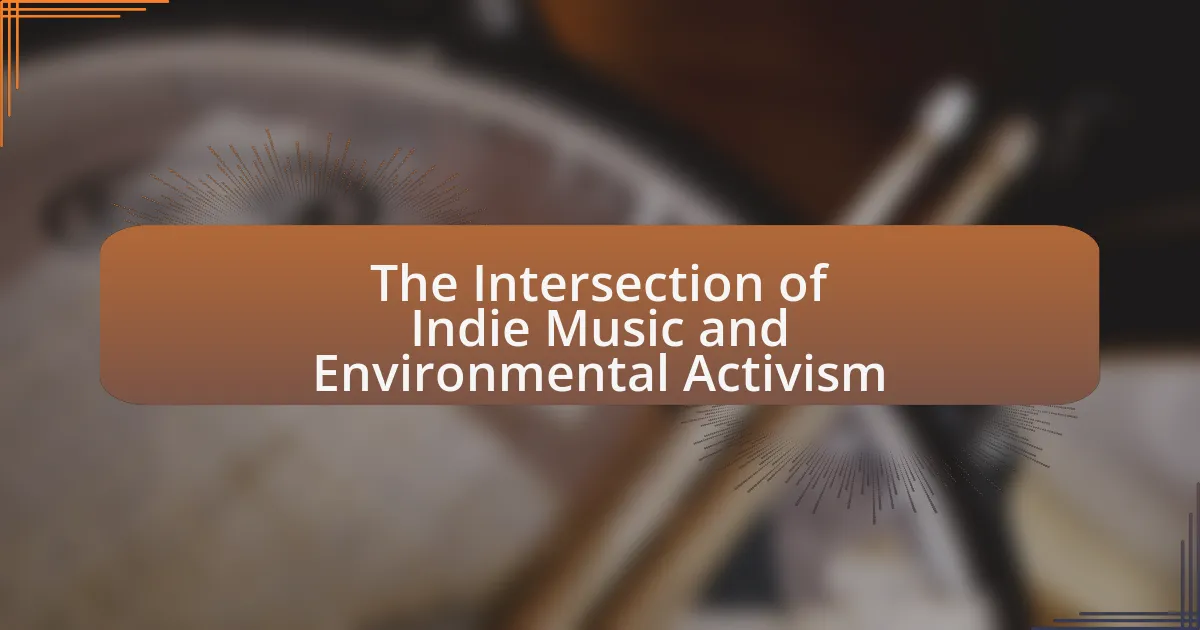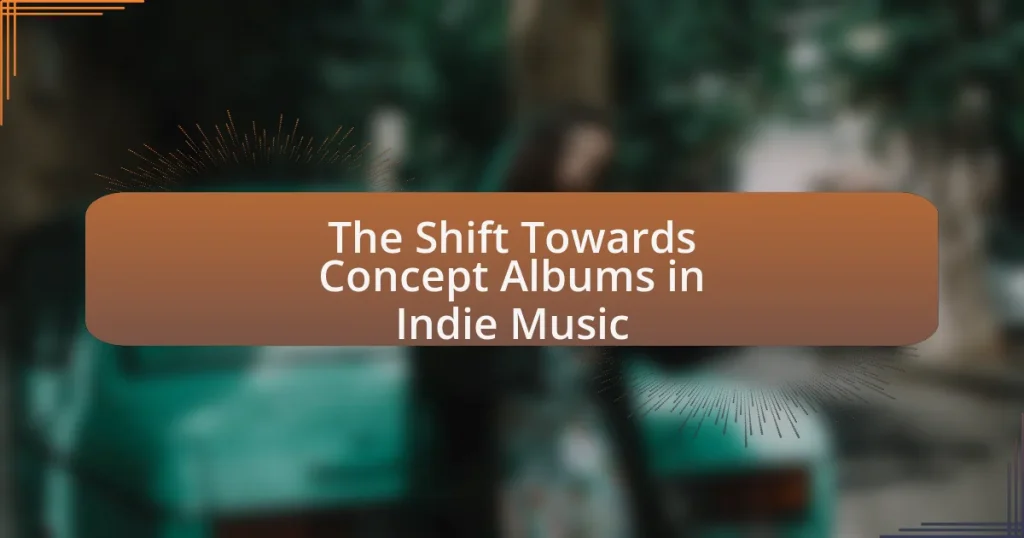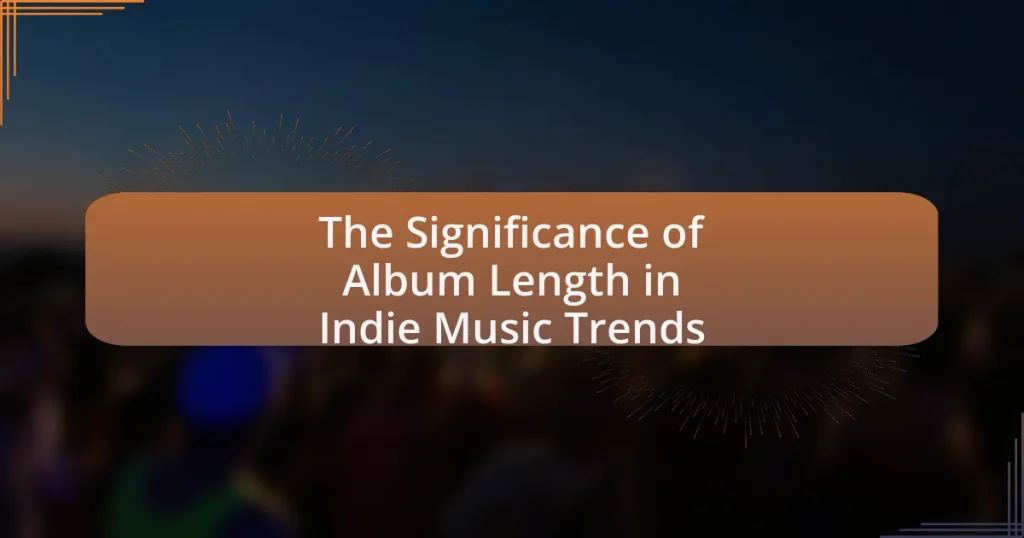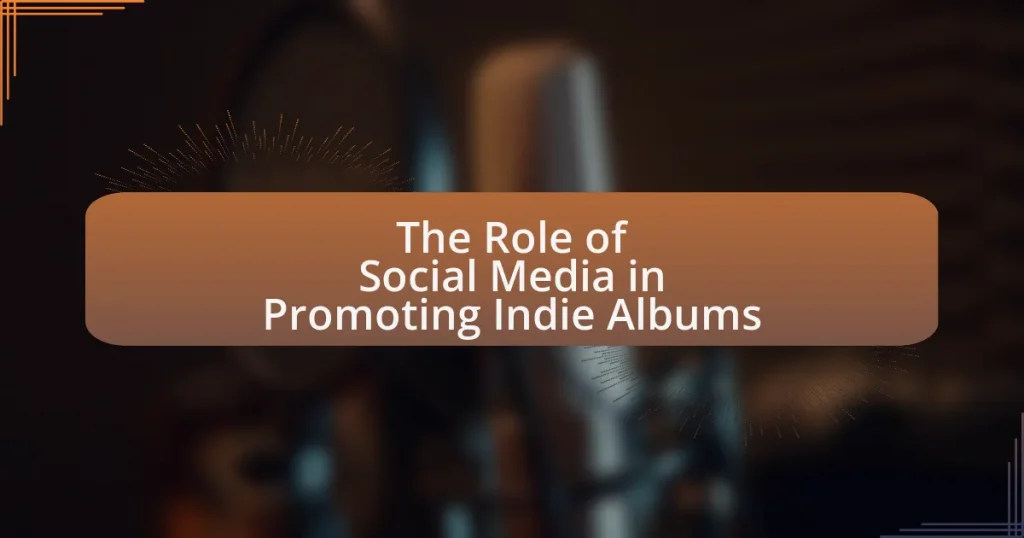The article explores the intersection of indie music and environmental activism, highlighting how indie musicians use their platforms to raise awareness and inspire action on ecological issues. It discusses the incorporation of environmental themes in lyrics, participation in benefit concerts, and collaborations with organizations focused on sustainability. Key movements such as the Green Music Initiative and notable artists like Billie Eilish and Jack Johnson are examined for their contributions to environmental causes. Additionally, the article outlines the role of music festivals in promoting sustainability and provides insights into how fans can support eco-conscious initiatives within the indie music community.
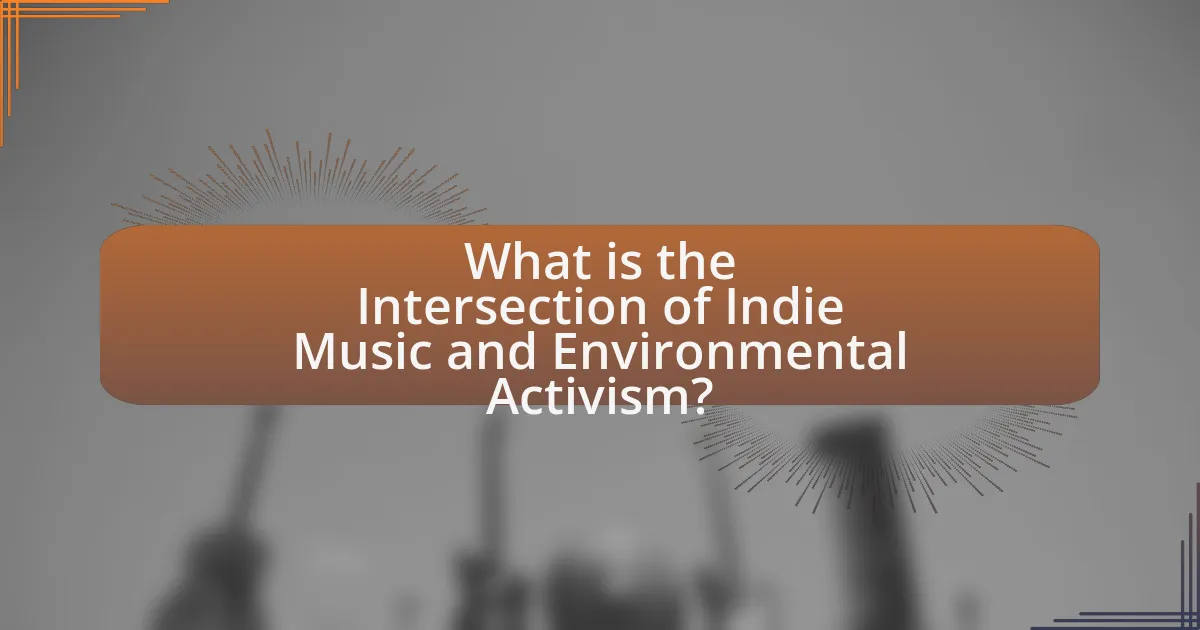
What is the Intersection of Indie Music and Environmental Activism?
The intersection of indie music and environmental activism lies in the genre’s ability to raise awareness and inspire action on ecological issues through artistic expression. Indie musicians often incorporate themes of environmentalism in their lyrics and public personas, using their platforms to advocate for sustainability and climate action. For instance, artists like Jack Johnson and Ben Harper have been known to support environmental causes, with Johnson founding the Kokua Hawaii Foundation to promote environmental education. Additionally, events like the Green Music Initiative encourage musicians to adopt eco-friendly practices, demonstrating a commitment to reducing the carbon footprint of the music industry. This synergy between indie music and environmental activism not only amplifies the message of sustainability but also mobilizes fans to engage in ecological efforts.
How do indie musicians engage with environmental issues?
Indie musicians engage with environmental issues primarily through their music, activism, and community initiatives. Many indie artists incorporate themes of environmentalism into their lyrics, raising awareness about climate change and sustainability. For example, artists like Ben Harper and Joni Mitchell have addressed ecological concerns in their songs, prompting listeners to reflect on environmental challenges. Additionally, indie musicians often participate in benefit concerts and collaborate with environmental organizations, such as the Surfrider Foundation, to promote ocean conservation. Research indicates that music can effectively mobilize communities around social issues, making indie musicians influential advocates for environmental causes.
What themes related to environmentalism are prevalent in indie music?
Indie music frequently explores themes of environmentalism, including climate change, nature preservation, and critiques of consumerism. Artists often use their platforms to raise awareness about ecological issues, reflecting a growing concern for the planet. For instance, songs may highlight the impact of pollution on natural landscapes or advocate for sustainable living practices. This thematic focus is supported by the increasing number of indie musicians participating in environmental campaigns and initiatives, such as the “Music Climate Revolution” movement, which emphasizes the role of artists in promoting climate action.
How do indie artists use their platforms to promote environmental causes?
Indie artists promote environmental causes by leveraging their music platforms to raise awareness and inspire action. They often incorporate eco-friendly themes into their lyrics, engage in social media campaigns, and collaborate with environmental organizations to amplify their message. For instance, artists like Billie Eilish and Jack Johnson have used their concerts to advocate for sustainability, with Eilish’s “Where Do We Go?” tour implementing zero-waste initiatives and Johnson’s Kokua Hawaii Foundation supporting environmental education. These actions demonstrate how indie musicians effectively utilize their influence to foster a culture of environmental responsibility among their fans.
Why is the intersection of indie music and environmental activism significant?
The intersection of indie music and environmental activism is significant because it amplifies awareness and mobilizes action on environmental issues through a culturally resonant medium. Indie musicians often use their platforms to address climate change, sustainability, and ecological justice, reaching diverse audiences and fostering community engagement. For instance, events like the “Green Music Fest” showcase artists who advocate for environmental causes, demonstrating the genre’s commitment to activism. Additionally, studies show that music can influence public perception and behavior regarding environmental issues, making indie music a powerful tool for advocacy.
What impact does indie music have on public awareness of environmental issues?
Indie music significantly enhances public awareness of environmental issues by using its platform to address ecological themes and promote activism. Many indie artists incorporate environmental messages into their lyrics and music videos, effectively reaching diverse audiences. For instance, the band The 1975 has released songs that discuss climate change and sustainability, while artists like Billie Eilish advocate for environmental causes through their social media presence and concert tours. Research indicates that music can influence public perception and behavior regarding environmental issues, as seen in studies showing that songs with ecological themes can inspire listeners to engage in pro-environmental actions. Thus, indie music serves as a vital conduit for raising awareness and mobilizing support for environmental activism.
How does the indie music community contribute to environmental movements?
The indie music community contributes to environmental movements by raising awareness and funds through concerts, festivals, and merchandise sales. Many indie artists actively promote environmental causes in their music and public statements, encouraging fans to engage in sustainability efforts. For example, events like the “Green Music Festival” showcase artists who prioritize eco-friendly practices, while initiatives such as “Music Declares Emergency” mobilize musicians to advocate for climate action. Additionally, indie labels often adopt sustainable practices in their operations, further aligning their business models with environmental goals.
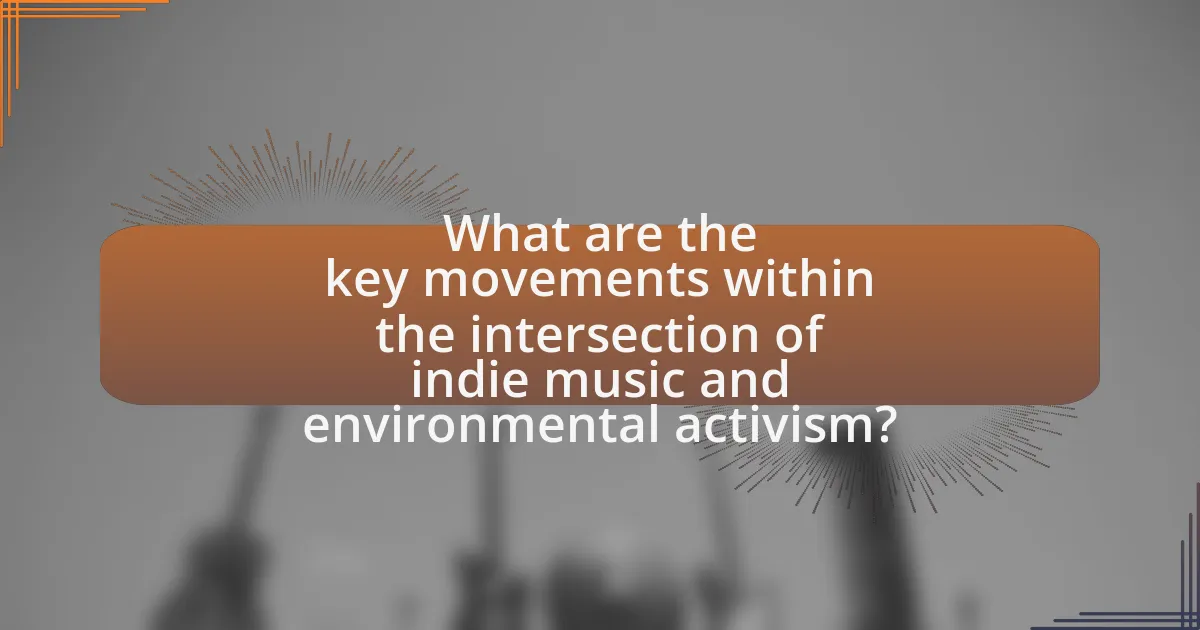
What are the key movements within the intersection of indie music and environmental activism?
Key movements within the intersection of indie music and environmental activism include the Green Music Initiative, which promotes sustainable practices in the music industry, and the Music Climate Revolution, advocating for climate action through music. These movements leverage the influence of indie artists to raise awareness about environmental issues, often organizing benefit concerts and campaigns that directly support environmental organizations. For instance, the Green Music Initiative has collaborated with festivals to implement eco-friendly measures, demonstrating a commitment to sustainability within the indie music scene.
Which notable indie artists are leading the charge in environmental activism?
Notable indie artists leading the charge in environmental activism include Billie Eilish, who has actively campaigned for climate change awareness and participated in various environmental initiatives, and Ben Howard, known for his support of ocean conservation efforts. Eilish’s involvement includes her partnership with organizations like Greenpeace, where she advocates for sustainable practices and climate action. Howard has collaborated with Surfers Against Sewage, promoting clean oceans and environmental protection. These artists exemplify the intersection of indie music and environmental activism through their public platforms and advocacy efforts.
What specific actions have these artists taken to support environmental causes?
Many indie artists have actively supported environmental causes through various initiatives. For example, Billie Eilish has partnered with organizations like Reverb to promote sustainable touring practices, reducing waste and carbon footprints during her concerts. Similarly, Jack Johnson has established the Kokua Hawaii Foundation, which funds environmental education in schools and promotes sustainability. Additionally, artists like Ben Harper have participated in campaigns such as “1% for the Planet,” pledging a portion of their earnings to environmental nonprofits. These actions demonstrate a commitment to environmental activism within the indie music community.
How do collaborations between indie musicians and environmental organizations manifest?
Collaborations between indie musicians and environmental organizations manifest through joint events, fundraising initiatives, and awareness campaigns. These partnerships often involve musicians performing at benefit concerts where proceeds support environmental causes, such as climate change mitigation or wildlife conservation. For instance, the “Green Music Initiative” has seen indie artists participate in eco-friendly festivals, promoting sustainability while engaging their audience. Additionally, musicians may use their platforms to amplify environmental messages, as seen when artists like Jack Johnson and Ben Harper have partnered with organizations like Surfrider Foundation to advocate for ocean protection. Such collaborations effectively combine artistic expression with activism, fostering community engagement and raising funds for critical environmental issues.
What role do music festivals play in promoting environmental activism?
Music festivals play a significant role in promoting environmental activism by serving as platforms for awareness, education, and community engagement. These events often incorporate sustainability initiatives, such as waste reduction programs, renewable energy sources, and eco-friendly practices, which encourage attendees to adopt environmentally conscious behaviors. For instance, festivals like Glastonbury have implemented extensive recycling and composting systems, reducing waste by over 50% in recent years. Additionally, many festivals partner with environmental organizations to provide information and resources, fostering a culture of activism among participants. This combination of entertainment and advocacy effectively mobilizes large audiences, amplifying the message of environmental stewardship and inspiring action beyond the festival grounds.
How are indie music festivals incorporating sustainability practices?
Indie music festivals are incorporating sustainability practices by implementing waste reduction strategies, promoting eco-friendly transportation, and utilizing renewable energy sources. For instance, many festivals now offer recycling and composting stations to minimize landfill waste, with events like the Bonnaroo Music and Arts Festival reporting a diversion of over 60% of waste from landfills through these initiatives. Additionally, festivals encourage attendees to use public transport or carpooling, which reduces carbon emissions; the Coachella Valley Music and Arts Festival has partnered with local transit authorities to provide shuttle services. Furthermore, some festivals are transitioning to solar power and other renewable energy sources, with events like the Shambhala Music Festival achieving 100% renewable energy usage. These practices not only enhance the environmental responsibility of indie music festivals but also resonate with the values of their audiences.
What initiatives are taken by festivals to raise awareness about environmental issues?
Festivals implement various initiatives to raise awareness about environmental issues, including waste reduction programs, educational workshops, and partnerships with environmental organizations. For instance, many festivals adopt a zero-waste policy, encouraging attendees to recycle and compost, which significantly reduces landfill contributions. Additionally, festivals often host workshops that educate participants on sustainability practices, such as reducing plastic use and promoting renewable energy. Collaborations with environmental organizations, like Greenpeace or the Sierra Club, further amplify their message by providing resources and expertise, thereby enhancing the overall impact of their environmental initiatives.
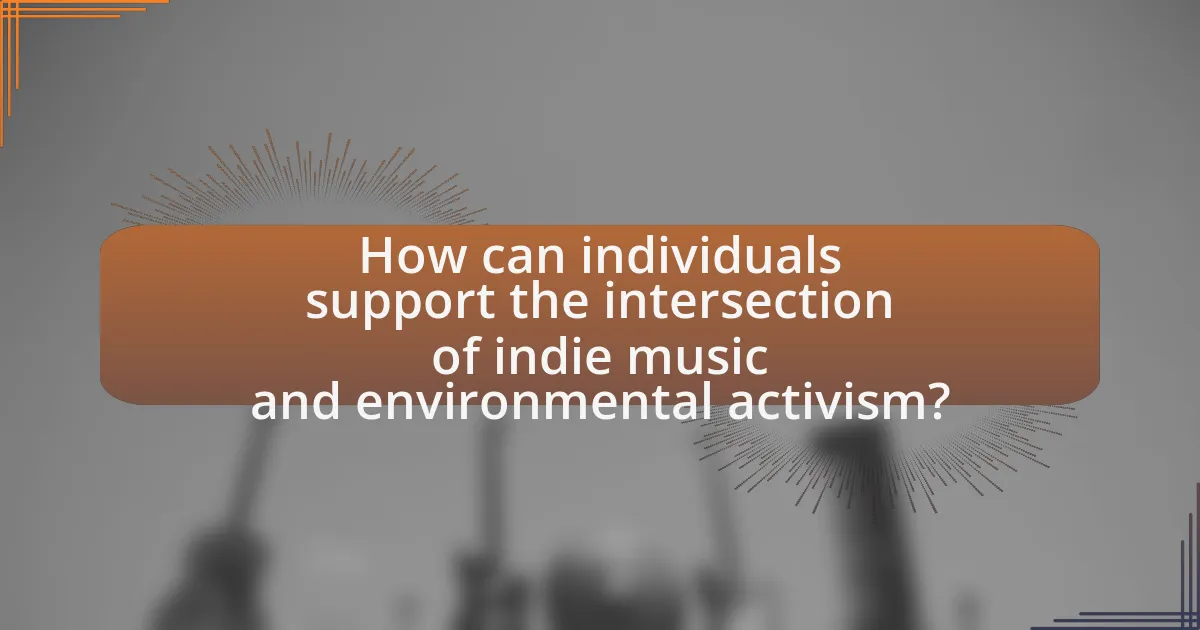
How can individuals support the intersection of indie music and environmental activism?
Individuals can support the intersection of indie music and environmental activism by attending concerts and festivals that prioritize sustainability and eco-friendly practices. Many indie music events now incorporate green initiatives, such as waste reduction, carbon offsetting, and promoting local, sustainable vendors. For example, the Green Music Initiative has partnered with various festivals to implement environmentally conscious practices, demonstrating that the music industry can contribute positively to environmental causes. By participating in these events, individuals not only enjoy music but also actively support the movement towards a more sustainable future.
What are effective ways to engage with indie music that promotes environmental causes?
Effective ways to engage with indie music that promotes environmental causes include attending concerts and festivals that feature eco-conscious artists, supporting music platforms that prioritize sustainability, and participating in community events that combine music with environmental activism. For instance, events like the Green Music Festival showcase artists committed to environmental issues, raising awareness and funds for related causes. Additionally, streaming services such as Bandcamp allow users to discover indie artists who advocate for sustainability, often donating a portion of their proceeds to environmental organizations. Engaging with social media campaigns led by these artists can also amplify their messages and foster a community of like-minded individuals dedicated to environmental advocacy through music.
How can fans contribute to the environmental efforts of their favorite indie artists?
Fans can contribute to the environmental efforts of their favorite indie artists by actively supporting eco-friendly initiatives and practices promoted by these artists. For instance, fans can participate in crowdfunding campaigns for sustainable projects, attend concerts that prioritize green practices, and purchase merchandise made from recycled materials. Research indicates that 70% of consumers are willing to pay more for sustainable products, demonstrating the impact of fan support on artists’ environmental initiatives. By engaging in these activities, fans not only amplify the artists’ messages but also foster a community dedicated to environmental stewardship.
What resources are available for discovering eco-conscious indie music?
Resources for discovering eco-conscious indie music include platforms like Bandcamp, which features artists who prioritize sustainability in their music production and distribution. Additionally, websites such as Eco Warrior Princess and The Green Music Initiative provide curated lists and articles highlighting eco-friendly indie musicians. Streaming services like Spotify also have playlists dedicated to environmentally conscious artists, showcasing their commitment to sustainability. Furthermore, social media groups and forums focused on indie music often share recommendations for eco-conscious artists, fostering community engagement around this niche.
What best practices can indie musicians adopt to enhance their environmental impact?
Indie musicians can enhance their environmental impact by adopting sustainable practices such as using eco-friendly materials for merchandise, reducing waste during tours, and promoting digital distribution over physical formats. For instance, utilizing organic cotton for clothing and biodegradable packaging for physical products minimizes environmental harm. Additionally, musicians can implement a zero-waste policy during tours by minimizing single-use plastics and encouraging recycling. A study by the Music Industry Research Association found that digital music distribution reduces carbon emissions significantly compared to traditional physical formats, supporting the shift towards digital platforms. By integrating these practices, indie musicians can contribute positively to environmental sustainability while engaging their audience in eco-conscious initiatives.
How can indie artists incorporate sustainability into their music production?
Indie artists can incorporate sustainability into their music production by utilizing eco-friendly materials and practices throughout the recording process. This includes using sustainable instruments made from responsibly sourced wood, opting for digital distribution to reduce physical waste, and employing energy-efficient recording techniques. For instance, a study by the Music Industry Research Association found that digital music distribution can significantly lower carbon footprints compared to traditional physical formats. Additionally, artists can collaborate with green organizations to promote environmental awareness through their music, further aligning their artistic vision with sustainable practices.
What strategies can musicians use to effectively communicate their environmental messages?
Musicians can effectively communicate their environmental messages by integrating eco-conscious themes into their lyrics, utilizing social media platforms for outreach, and collaborating with environmental organizations. By embedding environmental narratives in their songs, artists can raise awareness and inspire action among listeners. For instance, songs like “Earth” by Lil Dicky highlight climate change issues, making them relatable and urgent. Additionally, musicians can leverage social media to engage their audience in discussions about sustainability, share educational content, and promote eco-friendly initiatives. Collaborations with organizations such as Greenpeace or the Sierra Club can amplify their message, providing credibility and a broader platform for advocacy. These strategies have been shown to resonate with audiences, as evidenced by the increased public engagement in environmental issues linked to music campaigns.
